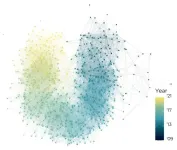(Press-News.org) Certain factors associated with developing age-related hearing loss differ by sex, including weight, smoking behavior, and hormone exposure, according to a study published on March 6, 2024 in the open-access journal PLOS ONE by Dong Woo Nam from Chungbuk National University Hospital, South Korea, and colleagues.
Age-related hearing loss (ARHL), slowly-advancing difficulty in hearing high-frequency sounds, makes spoken communication more challenging, often leading to loneliness and depression. Roughly 1 in 5 people around the world suffer from hearing loss, and this number is expected to rise as the global population ages. Since ARHL is irreversible, identifying it early and taking preventative measures are especially important. To better understand the factors associated with ARHL, and how the relative influence of these factors is shaped by sex, the researchers analyzed check-up health examination data from 2,349 participants aged over 60. After gathering each participant’s medical history and performing blood tests, a body composition test, and a basic hearing test, they ran statistical analyses to identify factors most strongly associated with ARHL risk for males and females.
The researchers found that while some factors – such as age – were associated with ARHL regardless of gender, others were differently associated with ARHL risk in males and females. For example, while being underweight showed a significant association with ARHL in males, both low weight and obesity showed significant associations in females. Smoking was associated with increased ARHL risk in males only, who were far more likely than females to identify as smokers in this sample population. Females who started menstruating at an earlier age were less likely to develop ARHL later in life, pointing towards a possible protective effect of the hormone estrogen.
This study does not allow elucidation of causal relationships between these factors and hearing loss, and further experimental studies will be necessary to confirm and better interpret these findings. However, the authors propose that assessing and counseling patients about their smoking behavior, weight, and menstruation may help improve screening and preventative treatment for ARHL.
The authors add: “Hearing loss should be prevented, even it is related to aging.”
#####
In your coverage please use this URL to provide access to the freely available article in PLOS ONE: https://journals.plos.org/plosone/article?id=10.1371/journal.pone.0298048
Citation: Nam DW, Park M-H, Jeong SJ, Lee KL, Kim JW, Jeong JB (2024) Sex differences in associated factors for age-related hearing loss. PLoS ONE 19(3): e0298048. https://doi.org/10.1371/journal.pone.0298048
Author Countries: Republic of Korea
Funding: The author(s) received no specific funding for this work.
END
Factors associated with age-related hearing loss differ between males and females
Weight, smoking, and hormone exposure show varying links with risk of age-related hearing loss, per study of 2,349 males and females
2024-03-06
ELSE PRESS RELEASES FROM THIS DATE:
Higher BMI is significantly associated with worse mental health, especially in women, per study of middle-aged and older adults which adjusted for lifestyle and demographic factors
2024-03-06
Higher BMI is significantly associated with worse mental health, especially in women, per study of middle-aged and older adults which adjusted for lifestyle and demographic factors
###
Article URL: https://journals.plos.org/plosone/article?id=10.1371/journal.pone.0299029
Article Title: Associations between adiposity measures and depression and well-being scores: A cross-sectional analysis of middle- to older-aged adults
Author Countries: Ireland
Funding: This research was funded by the Irish Health Research Board, grant number: HRC/2007/13. The funder had no role in the ...
This injectable hydrogel mitigates damage to the right ventricle of the heart
2024-03-06
An injectable hydrogel can mitigate damage to the right ventricle of the heart with chronic pressure overload, according to a new study published March 6 in Journal of the American College of Cardiology: Basic to Translational Science.
The study, by a research team from the University of California San Diego, Georgia Institute of Technology and Emory University, was conducted in rodents. In 2019, this same hydrogel was shown to be safe in humans through an FDA-approved Phase 1 trial in people who suffered a heart attack. As a result of the new preclinical ...
Giant dinosaur was “heron from hell,” not a deep diver, says new analysis
2024-03-06
For years, controversy has swirled around how a Cretaceous-era, sail-backed dinosaur—the giant Spinosaurus aegyptiacus—hunted its prey. Spinosaurus was among the largest predators ever to prowl the Earth and one of the most adapted to water, but was it an aquatic denizen of the seas, diving deep to chase down its meals, or a semiaquatic wader that snatched prey from the shallows close to shore?
A new analysis led by paleontologists from the University of Chicago reexamines the density ...
New deep-sea worm discovered at methane seep off Costa Rica
2024-03-06
Greg Rouse, a marine biologist at UC San Diego’s Scripps Institution of Oceanography, and other researchers have discovered a new species of deep-sea worm living near a methane seep some 50 kilometers (30 miles) off the Pacific coast of Costa Rica. Rouse, curator of the Scripps Benthic Invertebrate Collection, co-authored a study describing the new species in the journal PLOS ONE that was published on March 6.
The worm, named Pectinereis strickrotti, has an elongated body that is flanked by a row of feathery, gill-tipped appendages called ...
Nanosurgical tool could be key to cancer breakthrough
2024-03-06
The high-tech double-barrel nanopipette, developed by University of Leeds scientists, and applied to the global medical challenge of cancer, has - for the first time - enabled researchers to see how individual living cancer cells react to treatment and change over time – providing vital understanding that could help doctors develop more effective cancer medication.
The tool has two nanoscopic needles, meaning it can simultaneously inject and extract a sample from the same cell, expanding its potential uses. And the platform’s high level of semi-automation has sped ...
Genetic mutation in a quarter of all Labradors hard-wires them for obesity
2024-03-06
New research finds around a quarter of Labrador retriever dogs face a double-whammy of feeling hungry all the time and burning fewer calories due to a genetic mutation.
This obesity-driving combination means that dog owners must be particularly strict with feeding and exercising their Labradors to keep them slim.
The mutation is in a gene called POMC, which plays a critical role in hunger and energy use.
Around 25% of Labradors and 66% of flatcoated retriever dogs have the POMC mutation, which researchers previously showed causes increased interest in food ...
MIT scientists use a new type of nanoparticle to make vaccines more powerful
2024-03-06
CAMBRIDGE, MA -- Many vaccines, including vaccines for hepatitis B and whooping cough, consist of fragments of viral or bacterial proteins. These vaccines often include other molecules called adjuvants, which help to boost the immune system’s response to the protein.
Most of these adjuvants consist of aluminum salts or other molecules that provoke a nonspecific immune response. A team of MIT researchers has now shown that a type of nanoparticle called a metal organic framework (MOF) can also provoke a strong immune response, by activating the innate immune system — the body’s first line of defense against ...
A noninvasive treatment for “chemo brain”
2024-03-06
CAMBRIDGE, MA -- Patients undergoing chemotherapy often experience cognitive effects such as memory impairment and difficulty concentrating — a condition commonly known as “chemo brain.”
MIT researchers have now shown that a noninvasive treatment that stimulates gamma frequency brain waves may hold promise for treating chemo brain. In a study of mice, they found that daily exposure to light and sound with a frequency of 40 hertz protected brain cells from chemotherapy-induced damage. The treatment also helped to prevent memory loss and impairment of other ...
Film festivals are becoming more diverse in several ways, new study reports
2024-03-06
A group of Tallinn University researchers has published an innovative study that sheds light on the intricate dynamics of the global film festival circuit, revealing insights into diversity and public value creation within the industry. The research demonstrates that festival programming has become more thematically diverse, and the inclusion of films by women creatives has increased between 2012–2021.
The study “Quantifying the global film festival circuit: Networks, diversity, and public value creation,” published open access in the PLOS ONE journal, provides a comprehensive analysis of over 600 film festivals worldwide, spanning a period ...
New hydrogen producing method is simpler and safer
2024-03-06
Researchers in Sweden unveiled a new concept for producing hydrogen energy more efficiently, splitting water into oxygen and hydrogen without the dangerous risk of mixing the two gases.
Developed at KTH Royal Institute of Technology in Stockholm, the new method decouples the standard electrolysis process for producing hydrogen gas, which splits water molecules by applying an electric current. In contrast with prevailing systems it produces the resulting oxygen and hydrogen gases separately rather than simultaneously in the same cell, where they need to be separated by membrane barriers
That separation eliminates the possibility of the gases mixing with the risk of explosions, says ...
LAST 30 PRESS RELEASES:
Orthopedics can play critical role in identifying intimate partner violence
Worms as particle sweepers
Second spider-parasitic mite described in Brazil
January 2026 issues of APA journals feature new research on autism, pediatric anxiety, psychedelic therapy, suicide prevention and more
Private equity acquired more than 500 autism centers over the past decade, new study shows
New cervical cancer screening guidelines from the US Department of Health and Human Services
Estimated burden of COVID-19 illnesses, medical visits, hospitalizations, and deaths in the US from October 2022 to September 2024
Smartphone use during school hours by US youth
Food insecurity and adverse social conditions tied to increased risk of long COVID in children
Earliest, hottest galaxy cluster gas on record could change our cosmological models
Greenland’s Prudhoe Dome ice cap was completely gone only 7,000 years ago, first GreenDrill study finds
Scientific validity of blue zones longevity research confirmed
Injectable breast ‘implant’ offers alternative to traditional surgeries
Neuroscientists devise formulas to measure multilingualism
New prostate cancer trial seeks to reduce toxicity without sacrificing efficacy
Geometry shapes life
A CRISPR screen reveals many previously unrecognized genes required for brain development and a new neurodevelopmental disorder
Hot flush treatment has anti-breast cancer activity, study finds
Securing AI systems against growing cybersecurity threats
Longest observation of an active solar region
Why nail-biting, procrastination and other self-sabotaging behaviors are rooted in survival instincts
Regional variations in mechanical properties of porcine leptomeninges
Artificial empathy in therapy and healthcare: advancements in interpersonal interaction technologies
Why some brains switch gears more efficiently than others
UVA’s Jundong Li wins ICDM’S 2025 Tao Li Award for data mining, machine learning
UVA’s low-power, high-performance computer power player Mircea Stan earns National Academy of Inventors fellowship
Not playing by the rules: USU researcher explores filamentous algae dynamics in rivers
Do our body clocks influence our risk of dementia?
Anthropologists offer new evidence of bipedalism in long-debated fossil discovery
Safer receipt paper from wood
[Press-News.org] Factors associated with age-related hearing loss differ between males and femalesWeight, smoking, and hormone exposure show varying links with risk of age-related hearing loss, per study of 2,349 males and females










